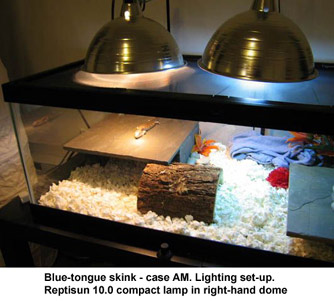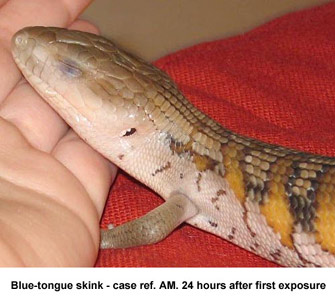|
|
This
is one case from a series of reports compiled as part
of an investigation into photo-kerato-conjunctivitis,
possibly occurring as a result of excessive low-wavelength
UVB radiation under certain brands of fluorescent
UVB lamp.
Please
do not view this one case without reference to the
whole report of which it is a part.
|
Case
History : AM
(New Jersey, USA) - Blue Tongue Skink
(Tiliqua scincoides)
A
one-month-old Northern Blue Tongued Skink (Tiliqua scincoides
intermedia) had been in its new home - a "30 breeder"
vivarium, size 36 in. by 18 in. by 12 in., for 7 days under
a ZooMed Reptisun 10.0 linear tube positioned above the
screen lid at a distance of 12 in., with no problems.
On
July 8th 2007, this was replaced by a new Reptisun 10 compact
in a 10-inch aluminium dome clamp lamp set on the screen,
again, 12 in. above the tank floor. (Figure 1.) The lamp
was to one side of the main basking spot - a raised platform
about 12 in. to the side of the lamp, above which was the
halogen basking lamp in an identical dome.
Within
24 hours, the baby skink was keeping his left eye closed
and the next day, kept both eyes permanently closed (Figure
2) and would bask and eat with his eyes closed, opening
them only when he moved around. His owner contacted the
breeder for advice, but the lamp was only discovered to
be the source of the problem on the third day (July 12th)
when his owner found reports of similar cases on an internet
forum.
She
removed the lamp immediately, and he began to open his eyes
again. However, the eyelids had become swollen and there
was noticeable skin damage, especially to the lower eyelids.
At first the lids were puffy (Figure 3) but by the end of
a week, the lesions on the lower lids had formed crusty
scabs and resembled burns. (Figure 4).
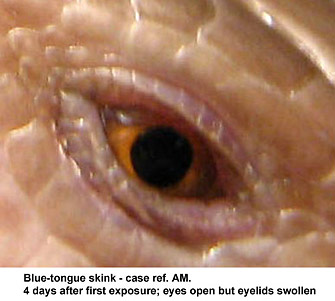 |
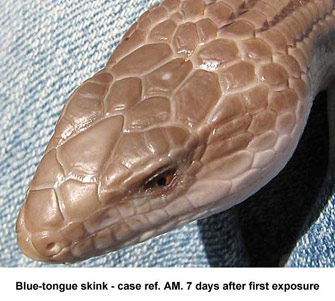 |
|
The
scabs came off a few hours after this photograph was
taken, and the left eye appeared to have lost a significant
amount of epidermis (Figure 5). Healing was slow,
but when the skink sloughed normally on 23rd July,
a significant improvement was seen.
Nevertheless,
a month later, after a second slough, there still
appears to be residual scarring to the lower left
eyelid and his owner reports that the eyelid appears
to be "stiff" and does not close as well as the other
one.
|
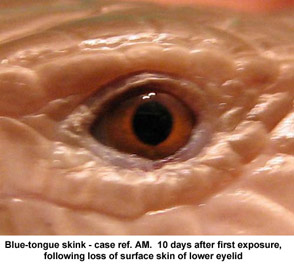 |
The
skink now has an Arcadia D3 Compact Reptile Lamp in the
reflective dome. His owner introduced this gradually, starting
with a four-hour period in the middle of the day, building
up over three weeks, to ten hours a day in the middle of
the twelve-hour photoperiod. He has also been taken outdoors
into natural sunlight for short periods during fine weather.
|


















